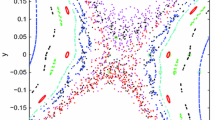Abstract
Chaotic dynamical systems are characterized by the existence of a predictability horizon, connected to the notion of Lyapunov time, beyond which predictions of the state of the system are meaningless. In order to study the main features of orbit determination in the presence of chaos, Spoto and Milani (Celest Mech Dyn Astron 124:295–309, 2016) applied the classical least-squares fit and differential correction algorithm to determine a chaotic orbit and a dynamical parameter of a simple discrete system—Chirikov standard map (cf. Chirikov in Phys Rep 52:263, 1979)—with observations distributed beyond the predictability horizon. They found a time limit beyond which numerical calculations are affected by numerical instability: the computability horizon. In this article, we aim at pushing forward such inherent obstacle to numerical calculations in chaotic orbit determination by applying the classical and the constrained multi-arc method (cf. Alessi et al. in Mon Not R Astron Soc 423:2270–2278, 2012) to the same dynamical system. These strategies entail the determination of an orbit when observations are grouped in separate observed arcs. For each arc, a set of initial conditions is determined and, in the case of the constrained multi-arc method, all subsequent arcs are constrained to belong to the same trajectory. We show that the use of these techniques in place of the standard least-squares method has significant advantages: Not only can we perform accurate numerical calculations well beyond the computability horizon, in particular, the constrained multi-arc strategy improves considerably the determination of the dynamical parameter.





Similar content being viewed by others
Notes
Since its introduction, Chirikov standard map has been used in Celestial Mechanics as a test problem to understand features of more complicated nearly integrable and dissipative models (cf. Celletti et al. 2010). Moreover, it locally approximates the Kepler map, an area-preserving map describing the motion of a celestial body on a nearly parabolic orbit (cf. Petrosky 1986; Chirikov and Vecheslavov 1986; Schevchenko 2011).
Weighing observations is a common technique used to take into account the possibility that some observations are more accurate than the others, for instance because they were realized with better instrumentation.
From another point of view, this is equivalent to having a different spacecraft for each arc.
The Lyapunov time of an orbit is the inverse of the largest Lyapunov exponent of that orbit and indicates the time after which the distance between two nearby trajectories increase by a factor e. The computation of the Lyapunov times of the orbits of Chirikov standard map is described in Spoto and Milani (2016).
For instance, the Cassini mission had 127 fly-bys with Titan alone.
References
Alessi, E.M., Cicalò, S., Milani, A., Tommei, G.: Desaturation manoeuvres and precise orbit determination for the BepiColombo mission. Mon. Not. R. Astron. Soc. 423, 2270–2278 (2012)
Anosov, D.: Geodesic flows on closed Riemann manifolds with negative curvature. In: Proceedings of the Steklov Institute of Mathematics, vol. 90 (1967)
Benkhoff, J., Casteren, J., Hayakawa, H., Fujimoto, M.H., Laakso, H., Novara, M., et al.: BepiColombo—comprehensive exploration of Mercury: mission overview and science goals. Planet. Space Sci. 58(1–2), 2–20 (2010)
Bowen, R.: \(\omega \)-limit sets for axiom A diffeomorphisms. J. Differ. Equ. 18, 333–356 (1975)
Celletti, A., Di Ruzza, S., Lothka, C., Stefanelli, L.: Nearly-integrable dissipative systems and celestial mechanics. Eur. Phys. J. Spec. Top. 186(1), 33–66 (2010)
Chirikov, B.: A universal instability of many-dimensional oscillator systems. Phys. Rep. 52, 263 (1979)
Chirikov, B., Vecheslavov, V.: Chaotic dynamics of comet Halley. Russian Preprint Institute of Nuclear Physics, pp. 86–184 (1986)
Dirkx, D., Gurvits, L., Lainey, V., Lari, G., Milani, A., Cimò, G., et al.: On the contribution of PRIDE-JUICE to Jovian system ephemerides. Planet. Space Sci. 147, 14–27 (2017)
Lighthill, J., Thompson, J., Sen, A., Last, A., Tritton, D., Mathias, P.: The recently recognized failure of predictability in Newtonian dynamics. Proc. R. Soc. Lond. Ser. A Math. Phys. Sci. 407(1832), 35–50 (1986). (and discussion)
Milani, A., Gronchi, G.F.: Theory of Orbit Determination. Cambridge University Press, Cambridge (2010)
Petrosky, T.: Chaos and cometary clouds in the solar system. Phys. Lett. A 117, 328–32 (1986)
Pilyugin, S.Y.: Shadowing in dynamical systems. In: Lectures Notes in Mathematics, vol. 1706 (1999)
Schevchenko, I.: The Kepler map in the three-body problem. New Astron. 16(2), 94–99 (2011)
Spoto, F., Milani, A.: Shadowing Lemma and chaotic orbit determination. Celest. Mech. Dyn. Astron. 124, 295–309 (2016)
Acknowledgements
D.S and A.M. have been partially supported by the University of Pisa via Grant PRA-2017 ‘Sistemi dinamici in analisi, geometria, logica e meccanica celeste’.
Author information
Authors and Affiliations
Corresponding author
Ethics declarations
Conflict of interest
The authors declare that they have no conflict of interest.
Additional information
This article is part of the topical collection on Innovative methods for space threats: from their dynamics to interplanetary missions.
Guest Editors: Giovanni Federico Gronchi, Ugo Locatelli, Giuseppe Pucacco and Alessandra Celletti.
Rights and permissions
About this article
Cite this article
Serra, D., Spoto, F. & Milani, A. A multi-arc approach for chaotic orbit determination problems. Celest Mech Dyn Astr 130, 75 (2018). https://doi.org/10.1007/s10569-018-9868-y
Received:
Revised:
Accepted:
Published:
DOI: https://doi.org/10.1007/s10569-018-9868-y




